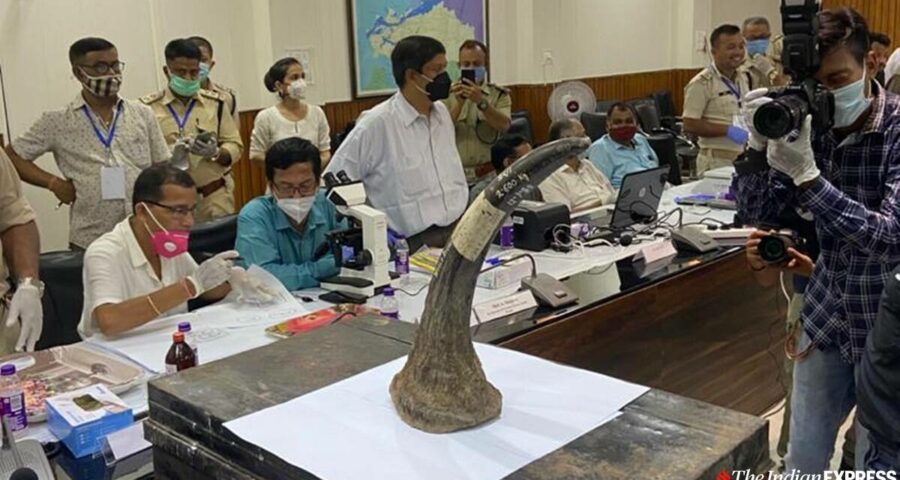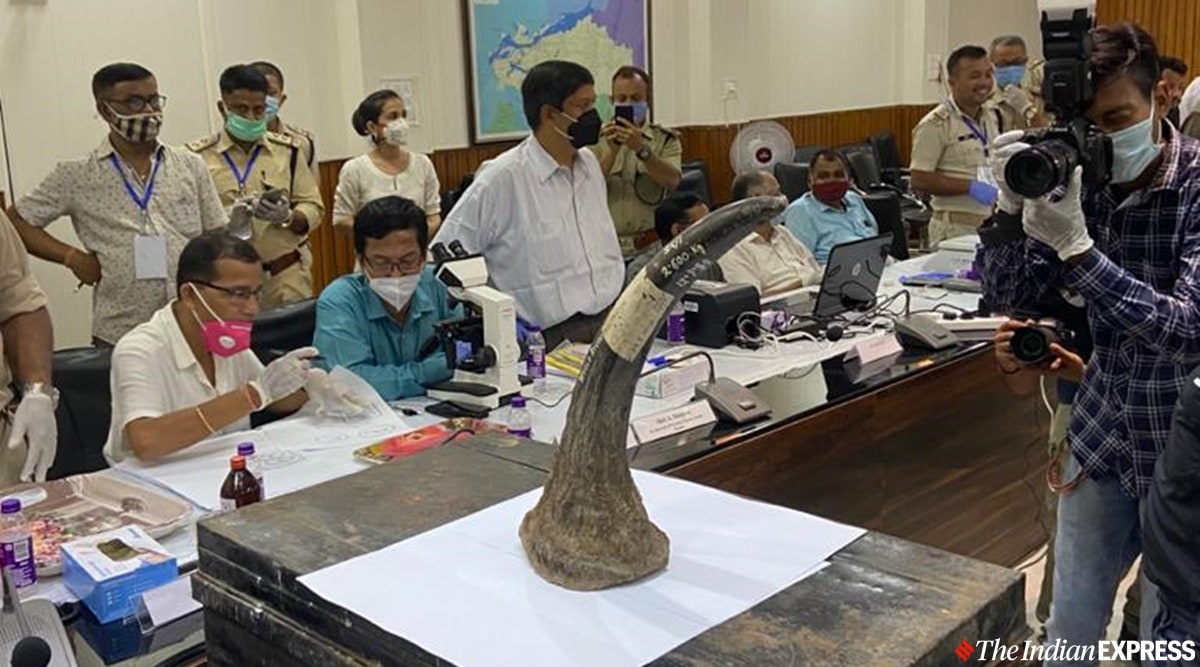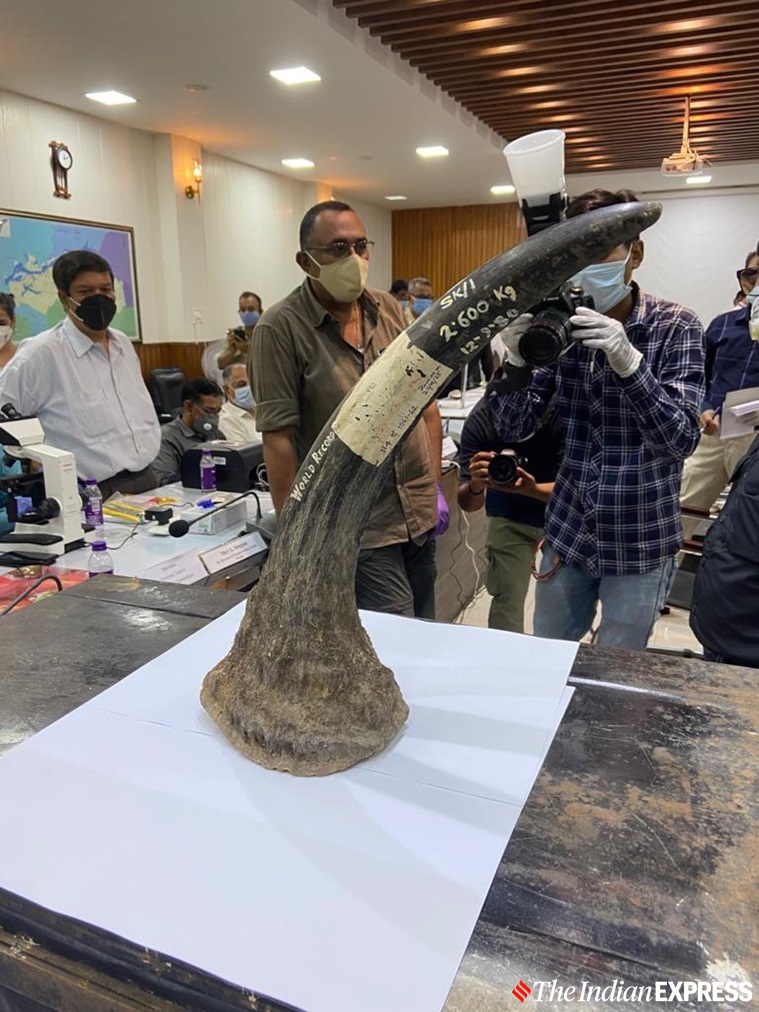For weeks now, a 'rhino horn re-verification’ programme by the Assam Forest Department has been underway, with an expert committee examining several hundred rhino horns stored in different district treasuries across Assam.
“Found in Nagaon’s Laokhowa sanctuary. Height 51.5 cm. Weight 2.5 kg. Dated 1961…older than many of us in this room,” said the official, with a smile.
For years now, the greyish-brown rhino horn, easily the length of one’s forearm, has led a quiet existence in a trunk of a government treasury in Assam — till it was brought out in front of a committee of forest department officials in Guwahati two weeks back.
The uniqueness of the horn — along the curve of which were the words ‘world record’ in small white letters — was not lost on the foresters, who burst into spontaneous applause at the sight of it. The item was then passed around the room — gloved hands deftly brushed off the dust on it, weighed it on scales, measured it with rulers and even extracted small samples from its rough, scratchy surface — before it was marked, bar-coded, packed and put back in another trunk. “Careful there, even a speck of dust from the horn is precious,” an official told another.
For weeks now, a ‘rhino horn re-verification’ programme by the Assam Forest Department has been underway, with an expert committee examining several hundred rhino horns stored in different district treasuries across Assam. The aim is to identify and classify such horns (collected from dead rhinos, either out of natural causes or poaching) and subsequently destroy them on World Rhino Day (September 21), subject to a public hearing and government approval. The ones that are unique — like the record-making horn from Nagaon dated to 1961 — will be earmarked and preserved in a scientifically-controlled environment.
“It’s a message to the poachers and smugglers…loud and clear…that such items have no value,” said MK Yadava, Chief Wildlife Warden, Assam, who is the chair of the exercise. However, in the illegal market such horns can fetch a high price. Thus the case for its destruction— a process which is in compliance with a section of the Wildlife (Protection) Act of 1972.
In 2016, following allegations that unscrupulous elements within the forest department had been illegally trading the horns in the treasuries and replacing them with fakes, the Assam government had held a similar re-verification program. However, the exercise found that most horns were genuine, save for five, which had anyway been recorded as fake at the time of deposition in the treasury.
This time, however, the exercise goes a step further, and has a conservation-oriented goal. According to Yadava, that is what makes it special.
“We have never done an exercise like this before. Every horn is being weighed to the last milligram, marked with a unique identification number, chiselled to extract DNA,” Yadava said, adding that the resultant gene database can play a crucial role in scientific study and future conversation of the species.
On August 7, Yadava notified the committee of experts to oversee the exercise that would span treasuries across seven wildlife zones in Assam (Morigaon, Manas, Mangaldai, Guwahati, Bokakhat, Nagaon and Tezpur) and examine more than 2,500 horns.
One Monday in August, The Indian Express visited one such exercise, underway in the Kamrup district’s deputy commissioner’s office in Guwahati. In the conference room, the committee — comprising DFOs, wildlife experts, forensic specialists and technicians — sat at their stations and sifted through 123 horns stored in seven weather-beaten trunks with exacting precision.
“Every rhino horn has a story,” said Hemkanta Talukdar, Chief Conservator of Forest, Central Assam Circle, and zonal chair for the Guwahati zone.“And what we are doing here is documenting that.”
Talukdar explained how for each rhino death (whether naturally or by poachers), ‘horn recovery’ is an important follow-up step done usually by the police. “After each death, a police file is opened, and details recorded,” he said. In the Kaziranga National Park, the UNESCO World Heritage site famous for the animal, each and every rhino death since 1976 has been recorded, with details like cause, horn size etc. documented.
At the DC office in Guwahati, horns of various shapes, sizes occupied the trunks, ranging from large (51 cm) to small (6 cm), heavy (2.5 kg) to light (20 gram), conical to stubby, collected from conservation habitats locations around Guwahati, such as Pobitora Wildlife Sanctuary and Manas National Park.
The process has multiple, laborious steps: first, the horn is deposited at the cleaning table, after which it is examined by a forensics team for genuineness. A Unique Identification Number is allotted to each horn, and then it is weighed, measured, and handed over to another team for DNA sampling.
The sampling is the time-consuming part: two officials drilled the horn, collected a five-gram sample, put it in a test tube and then deposited it in a plastic packet. “Every time we drill it, we have to change the sample ahead of the machine, to prevent contamination,” said an official. Apart from that, a one-gram sample from two horns from every ten years, was also collected for “structural and chemical composition analysis.”
At the end, a closing weight is recorded, and each horn is individually packed in cling film, labelled and put back in the boxes, tagged for preservation or disposal.
The entire operation was streamed live on large monitors outside the hall for public viewing and transparency. Padma Shri-winning veterinarian Kushal Konwar Sarma, who is part of the committee, said the process was “simple” but “it has to be done well.” “And with care,” added another committee member. “Few horns are very soft…while handling them, you may have rhino horn residue on the gloves…so we keep changing gloves, too, so as to not mix up two samples,” he said.
The exercise is scheduled to end on September 16, after 1,623 horns are studied in the last zone, Bokakhat (under which Kaziranga falls) over a period of ten days. There, the committee is expected to find in the stockpile, the world’s heaviest horn — weighing 3.051 kg and 36 cm in height —dated to 1982 from the Bagori Range of park.
“Each horn is a storehouse of information…a 50-year-old rhino horn will have some information you will find nowhere else,” said Sarma, adding that the DNA studies can potentially throw light on the “past as well as future of the species” as well as “migration patterns, health, and even possibly help in rhino crime analysis.”
After the day is over, the team will head to another location, and follow the exact process — the cleaning, drilling, weighing, and packing — one horn at a time. “It may be slow but for us, this is a once-in-a-lifetime opportunity… since it is not every day you get to see, study and experience the world’s biggest rhino horns,” said Sarma.
Source: Read Full Article



